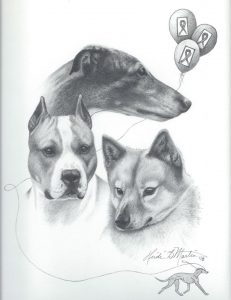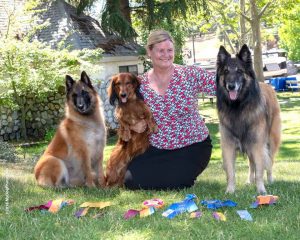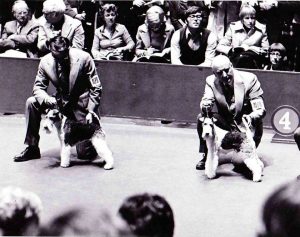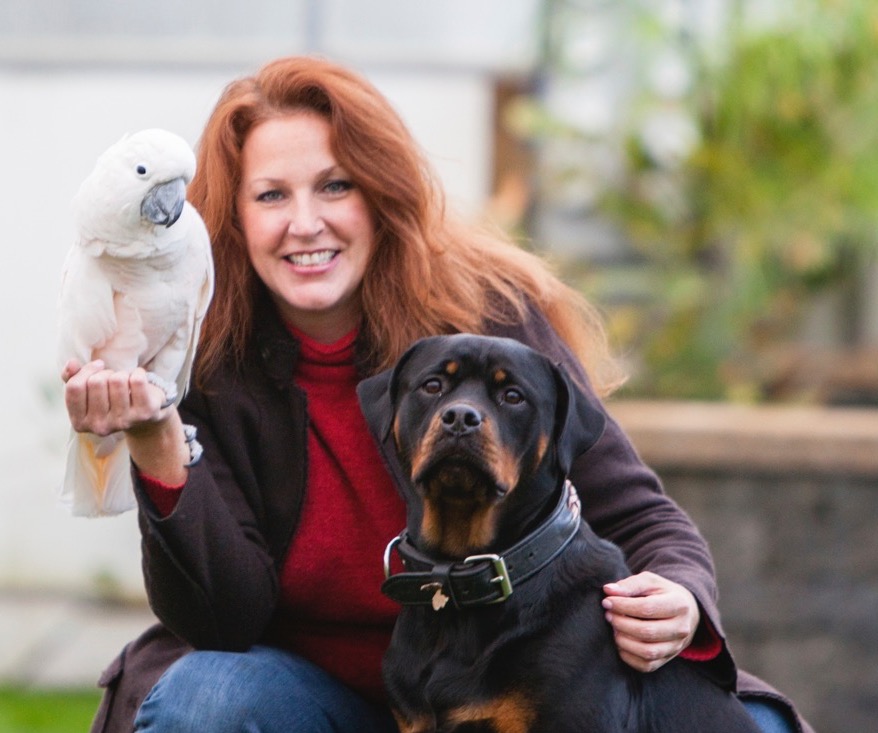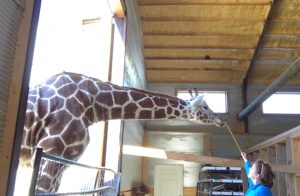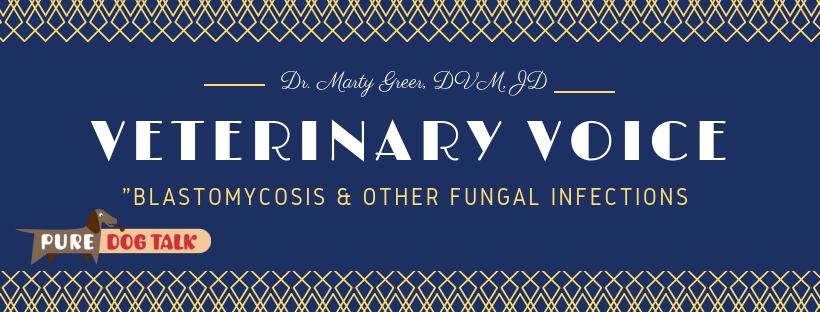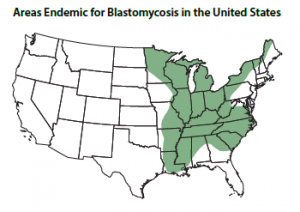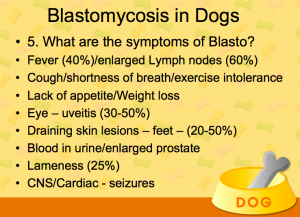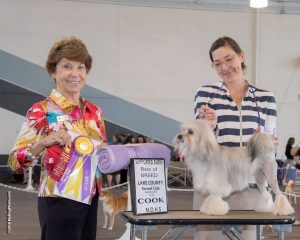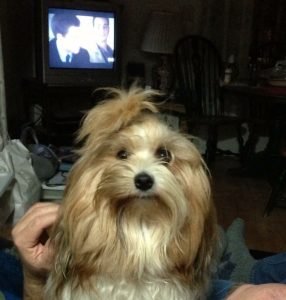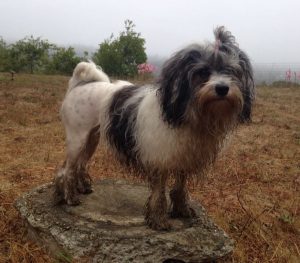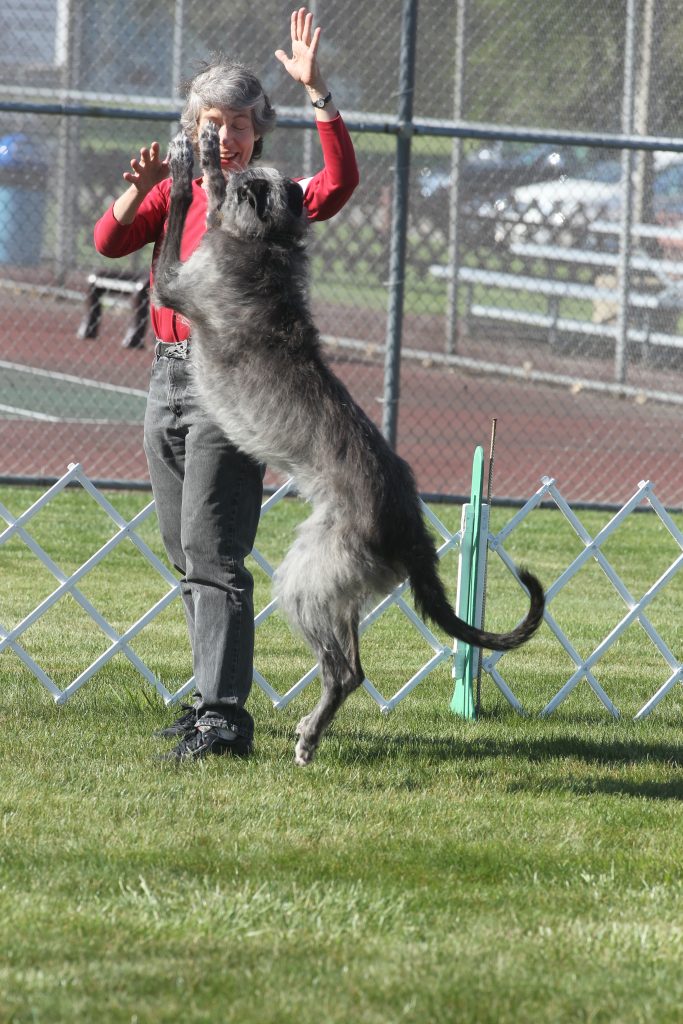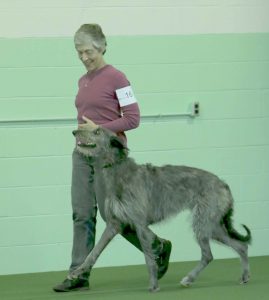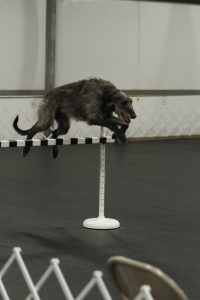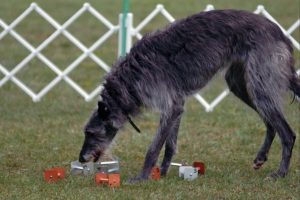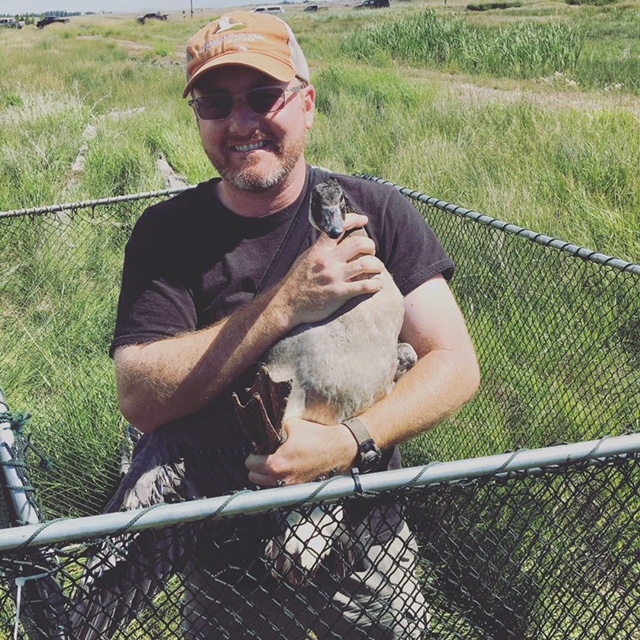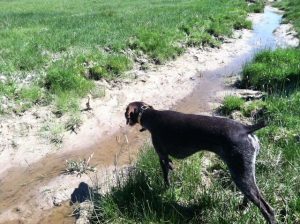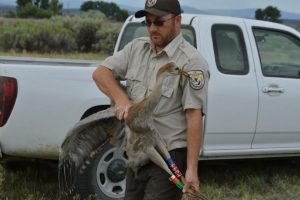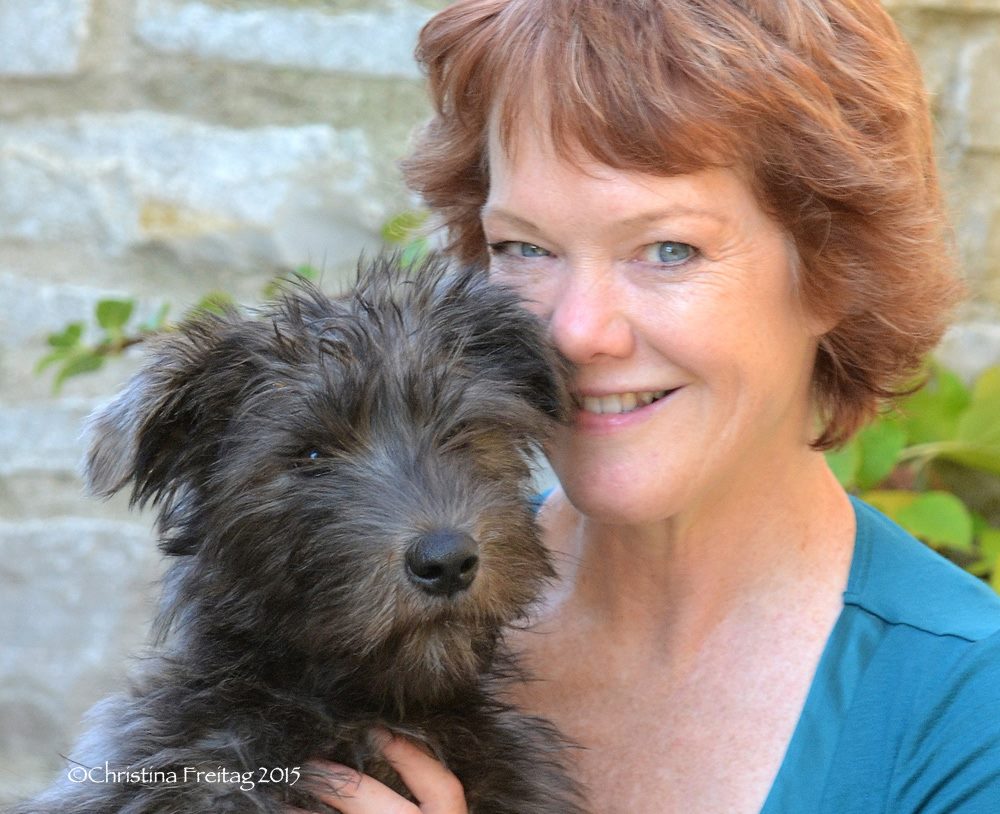220 – Take the Lead Charity Supports Dog Fancier “Family”
Take the Lead founder Tom Bradley on supporting our “family” of dog fanciers
Take the Lead started with a phone call. Tom Bradley shared his memory of receiving a call for help from a young friend in need. That one conversation, and the subsequent private assistance provided to this individual, launched an enduring gift to the entire dog community.
Since 1993, according to Bradley, Take the Lead has distributed more than $5.5 million in assistance to dog fanciers around the country affected by the AIDS epidemic, cancer and every kind of life-threatening and terminal illness.
“We call ourselves a family,” Bradley said. “I’ve been involved in the sport since 1954. AIDS was the impetus for starting this. It began with one friend who needed help.”
Bradley began his involvement in the sport as a teenager exhibiting and later breeding German Shorthaired Pointers, Pointers and Labrador Retrievers under the Luftnase kennel name. He owned and handled other breeds over the years including Cairn Terriers, Whippets, Cocker Spaniels and more recently Border Terriers.
Volunteers give time and money
Bradley is the executive director of the organization which is run by an entirely volunteer board of 28 fanciers scattered around the U.S.
“People are generous with their time and their dollars,” Bradley noted.
Today Take the Lead serves an average of 35-40 clients each month, Bradley said, with some continuing to receive assistance over an extended period of time. All applications are entirely confidential and are reviewed only by a committee of three founding members of the organization, he added.
Qualification for assistance is determined by application. Bradley acknowledged that the seven-page form is deeply personal, but the information contained in it, including a doctor’s letter and recent income tax filing, is necessary to ensure the funds entrusted to the organization are used appropriately.
Just recently, the organization added a special emergency assistance fund application for fanciers impacted by natural disasters such as floods, fires and earthquakes.
Take the Lead 25th Birthday Party at the Harvest Moon Cluster is one of many fundraising opportunities local clubs provide for the organization.
Events help raise funds
All of the money raised by Take the Lead, a 501c3 charitable organization, has been donated exclusively from within the fancy, Bradley noted. Support is provided by individuals, local kennel clubs, the AKC and dog food companies, he added.
Many local clubs hold fund-raising events, like the 25th Birthday Party celebration planned by the Harvest Moon Cluster in DelValle, Cali. next month. Tickets to the event are expected to sell out quickly and can be purchased on the Take the Lead website, www.takethelead.org, or by calling the office at 1-800-814-1123.
219 – Positive Solutions for Canine Aggression Issues
Tips and tools for managing canine aggression using positive reinforcement
Lisa Moore is a canine behavior counselor who works regularly for clients dealing with aggression issues in their dogs. She uses positive reinforcement and counter-conditioning methods to bring these dogs to a point at which they can be safely managed.
“One of my Belgian Tervuren had aggression issues,” Moore said. “The old techniques I had used were not going to be effective without somebody getting hurt. This was my primary motivation for making the switch to positive reinforcement and clicker training.”
A successful obedience competitor prior to her introduction to clicker training, Moore noted that, dog training is an unregulated profession. “Anybody can hang up a shingle and call themselves a dog trainer,” she said.
Moore strongly recommends working with a trainer certified by the Karen Pryor Academy and/or the Association of Professional Dog Trainers.
Common aggression issues
Moore shared advice on three very common types of aggression, how to identify the behavior and how to condition dogs correctly to be able to manage them:
- Fear aggression
- Leash reactivity
- Resource guarding
“Management will always play some sort of role when you have a reactive dog,” Moore noted.
Some general principles to keep in mind, according to Moore, when dealing with aggression issues.
- There is no room for corrections. Punishing any type of aggressive behavior will make it worse.
- There are no quick fixes. Corrections will suppress the behavior, but that is not a fix.
- Dogs will always have “tells” that will give you an early warning that trouble is brewing.
- Understand and listen to your dog.
Fear aggression, Moore said, is the easiest to fix. “You get the fear to go away, the aggression goes with it,” she added.
Leash reactivity is a situation in which Moore said, more often than not, she has to train the owner not the dog. “The owner tenses up, the dog reads that behavior and says ‘Mom’s worried, something must be wrong,’” she observed.
Resource guarding is a very common, solvable behavior, Moore said. Much more so when it is caught early, before it becomes entrenched. She added that dogs who become habituated to resource guarding can be particularly dangerous.
Learn more about applied behavior analysis in last week’s episode with Lara Joseph.
Allison Foley’s Tip of the Week from the Leading Edge Dog Show Academy regards mentorship and how to find it, and give it!
218 – Legendary Dog Man Peter Green Brings History to Life
Peter Green riffs on great dogs, great rivalries and great memories
Join a wonderful conversation between legendary dog man Peter Green and his former apprentice Robert Paust, now an AKC judge in his own right. The two old friends reminisce about great dogs of the past, great wins, great friendships and great rivalries.
Green’s Welshman brogue has blurred but not faded from his voice in the 50-plus years he’s been working with dogs in the U.S. Starting in dogs showing Welsh Terriers with his uncle, Green began his career in the States in 1963. As was common at the time, he worked as a private handler for a prominent kennel to learn the business.
WKC BIS with the Lakeland
His professional handling career kicked in to high gear after he won Best in Show at Westminster Kennel Club with the great Lakeland Terrier, Ch. Stingray of Derryabah, in 1968. In a career that spanned 40 years as one of the pre-eminent professional handlers in the country, Green piloted dogs to the big ribbon at the Garden four times. He is slated to judge BIS on the green carpet this coming February.
Green was very definite on his favorite dog of all time. In all the dogs, in all the years, the Wire Fox Terrier, Ch. Sunnybrook Spot On was his choice without hesitation.
Spot On vs Dominator and other great battles
Peter Green, left, with Spot on and George Ward, right, with Dominator in one of the most-watched rivalries of the era.
Listening to Green flashback to the tremendous competition with his friend and rival George Ward, showing Spot On’s son, Ch Aryee’s Dominator, is a rush. Even as he’s reminiscing, Green is teaching without even thinking about it. He talks about how he showcased his dog’s movement in this high-stakes competition.
Dog show drama was alive and well, even in the “good old days,” according to Green. Good natured rivalries, and even those that weren’t so pleasant, behind the scenes stories, flaring tempers and redemption all flow from his memories.
Enjoy this priceless window into history.
217 – Crate Training, Jumping Up, Digging and Behavior Analysis
Behavior analysis and positive reinforcement create success
Animal behaviorist Lara Joseph shares her expert knowledge on understanding our dog’s behavior, how to read signals from the dog and use behavior analysis to shape a new future.
Joseph knows for a fact that positive reinforcement training works. She uses it extensively with zoo animals and exotics, as well as companion dogs.
“You can’t use force or aversives on exotics,” Joseph said. “You know you can make your dog sit by pushing its butt down… try doing that with a giraffe!”
Joseph discusses redirecting behaviors by correctly identifying the reinforcers. In other words, what, exactly, does the dog want and how is the behavior he is exhibiting fulfilling that desire.
The “Terrible twos” are a tremendous opportunity to train a dog, Joseph said. The dog is at an age where it is constantly manipulating its environment to get the consequences it desires.
“The animal is learning contingencies and consequences in its environment,” Joseph noted. “If the animal can see, hear, smell or feel you, you are training it, whether you realize it or not. The key question is, what are you training it to do.”
Shaping Behaviors
Crate training, digging and jumping up are all “behaviors” that can be shaped, Joseph said. Redirecting the dog’s behavior requires correctly identifying the “reinforcer” – in other words what the dog wants – and then providing that reinforcer for an acceptable behavior.
She cautions against moving too quickly through a training plan. Start small and reinforce big.
“If you take too big of steps in your shaping plan,” Joseph said, “it can turn what you’re trying to train in to an aversive, something the dog doesn’t like.”
Joseph said that what dogs understand is contingencies – “if I do this, this happens…. If I do THIS, this doesn’t happen…”
Another important option is called a “Conditioned Reinforcer.” In other words, every time the dog goes in the crate, it gets a treat that it is available no other time.
Listen to your dog
Joseph also addressed the topic of aggression in dogs.
“Aggression serves a purpose for the dog,” Joseph observed. “It gets them what they want. If the growl didn’t work, he’ll try a lunge. If you pull your hand back, and the dog wanted you to retreat, it’s now learned what works.”
Hear what the dog is trying to tell you, Joseph said. Reinforce the good behavior. Pay attention to the dog. All dogs really want is attention. Be consistent. Create duration.
Check out our newest advertiser, Trupanion!
Don’t miss Allison Foley’s Tip of the Week from the Leading Edge Dog Show Academy: Overweight dogs and green beans!
Biography:
Lara Joseph is the owner of The Animal Behavior Center, an international, educational center focusing on teaching people how to work with animals using positive reinforcement and approaches in Applied Behavior Analysis. She is a professional animal behavior consultant and trainer. Lara travels internationally giving workshops, lectures, and provides online, live-streaming memberships on animal behavior, training and enrichment. Lara’s focus is on the companion animal community, zoos, shelters and wildlife ambassadors. Her daily work focuses on teaching people through her live-streaming services on animal training, behavior modification, and enrichment to people all over the world via her Projects and Memberships. She sits on the advisory board for All Species Consulting, The Indonesian Parrot Project, and is director of animal training for Nature’s Nursery, a wildlife rehabilitation center in Whitehouse, Ohio. She is also the founder of several animal organizations for animal welfare. She has been asked to co-author and is currently working on international manuals of animal behavior and training. Lara is a professional member of The Animal Behavior Management Alliance, The International Association of Avian Trainers and Educators, and The Pet Professional Guild. She is a published author and writes regularly for several periodicals including The Pet Professional Guild’ BARKS for professional dog trainers, a behavior columnist for BirdTalk Magazine, and contributes to blogging for Deaf Dogs Rock. She is a guest lecturer in the Zoo Biology; Animal Nutrition, Behavior & Diagnostics taught by Dr. Jason Crean at St. Xavier University; Chicago. Lara has presented for a wide variety of organizations such as The Philadelphia Zoo, The Ohio State Exotic Veterinary Club, The Association of Avian Veterinarians, Best Friends Animal Society, The Pet Professional Guild, The International Wildlife Rehabilitator’s Conference, The Autism Model School, and The Wheaton College division of Applied Behavior Analysis, and at Best Friends Animal Sanctuary for the Pet Professional’s Guild’s Workshop. For more information visit her website at TheAnimalBehaviorCenter.com. Also her Facebook page where she live streams a weekly episode on ABA and its use with animals called Coffee With The Critters: https://www.facebook.com/TheAnimalBehaviorCenterLlc/ Find her on Instagram: https://www.instagram.com/theanimalbehaviorcenter/
216 — Vet Voice: Blastomycosis and Other Fungal Infections
Blastomycosis is deadly hazard for dogs
Dr. Marty Greer, DVM, discusses the causes, symptoms and treatment of deadly Blastomycosis and other fungal infections. Greer notes that fully 25 percent of dogs affected by this disease will die.
Greer is notably not an alarmist, but she is adamant that Blastomycosis is a deadly and dangerous disease. Specific areas of the country, including the upper Midwest and South/East River valleys, are most commonly affected.
This particular fungal infection is contracted by spores inhaled from disrupted soil, particularly near water. Greer also addresses other fungal infections that can affect dogs.
The most common symptom of Blastomycosis is a dog that is coughing, sounding like pneumonia. The dogs will often also present with a draining sore on the foot that is of indeterminate cause.
Diagnostics for the disease are conducted on urine samples sent to a specific laboratory in Indiana. Dogs can decline rapidly, with acute onset of the disease in less than 24 hours. Treatment of the disease is expensive, time consuming and even successful treatment may leave the dog with permanent damage.
Dogs are treated with oral medication, with a 75 to 90 percent success rate, using the urine test to monitor efficacy of treatment.
Zoonotic disease
Blastomycosis is a zoonotic disease, meaning it affects people and animals. People will not be exposed by their sick dogs, but they can acquire the disease from the same source of disrupted soil. The spores live in the soil. She goes so far as to recommend dogs that pass from the disease be cremated, not buried, so as to not release more spores into the soil.
“There have been outbreaks where 120 people were sickened in one event,” Greer said. “It is bad, bad stuff. Nobody messes around with this. It is serious.”
Blasto can be a challenge to diagnose, as the early symptoms are similar to many other diseases, Greer said. She adds that owners should keep track of dogs after traveling to areas where the disease is prevalent.
215 – Lowchen in Danger: Could be Extinct in our Lifetime
Ancient Lowchen breed holds threatened future
Alexia Rodriguez, breeder and Lowchen Club of America Director, talks about these non-shedding, healthy, active “best kept secret” little lion dogs. With depictions dating to the 1400s in Germany, Lowchen see only 80 dogs total registered annually in the U.S.
Rodriguez said that in 2015, only 18 litters of Lowchen were whelped in the US, with an average litter size of only three puppies. On its current path, the club estimates Lowchen could become extinct by 2044.
“Our numbers indicate only 37 percent of dogs in the U.S. contribute to the gene pool,” Rodriguez said. She added that the tight line breeding required to re-establish the breed following WWII is suspected to be the cause of the low litter numbers. Nonetheless they breed and whelp naturally.
Best kept secret
“The thing I love the most,” Rodriguez said, “is that Lowchen can be high level agility or performance dogs, and then they are just as happy to lay on the couch and snuggle for three days if you don’t want to do anything.”
Lowchen’s unique coat and “lion” trim is relatively low-maintence, Rodriguez said.
“You can go tracking one day, and the next day, give them a bath and blow out, and they’re ready to go in the ring,” she added. “If a smooth coated Cane Corso person can handle it, most people can…”
In German, Lowchen means “little lion dog” so they were shaved in the shape of a lion, Rodriguez noted. The trim includes “bracelets” on all four legs, with each leg shaved about half way, the body shaved from the last rib back and the tail shaved about half way up. No scissoring is allowed.
“They are tie- dyed dogs,” Rodriguez noted. “They come in all colors. Sables even look like a lion.”
The luxurious coat is not all one texture of hair, Rodriquez said. “Parti colors tend to be a little more curly and cottony,” she added. “White coats are the most difficult and tend to mat. Blacks and sables tend to have more easy to manage coats.”
Legends of the Lowchen
The breed was developed in Germany. One legend has it, Rodriguez said, that if a knight was killed in battle, they put a lion on his tombstone. If he died at home, they’d put a Löwchen on the tombstone.
The breed was rumored to be a favorite of the ladies of European royalty because the dogs would attract fleas and keep them off the people.
Living with the Lowchen
Weighing about 15 pounds, the breed is easy to travel with, Rodriguez observed, and very healthy.
“As a breeder we test eyes, hips, knees. There are not many heart problems. We test for PRA,” she added. “Breeders in the breed are very open, and willingly and publicly share information.”
These healthy little dogs will often live 17 to 18 years, Rodriguez noted. They are resilient and not at all fragile. In fact, Rodriguez commented that they are phenomenal in agility, where they mostly compete in the 12” class.
For more information or breeder referral, visit:
http://www.thelowchenclubofamerica.org/
214 – Dancing with Dogs: Jere Marder, Lambluv OES
Her Dance Partner is Her Dog
Jere Marder was a high school teacher when her husband brought her an OES puppy as a Christmas present. Her world-renowned Lambluv Old English Sheepdogs are the result of a gift that has kept on giving for more than 40 years. She managed a successful breeding and show program for much of that time from a condo near Chicago.
But before that, she choreographed school musicals and taught at her own dance studio in the city. Lambluv dogs have reached #1 in both the Working group and since it was split in the Herding group. The first few were shown by a local professional handler, Jack Funk, but since then, Jere has taken over the leash and her top specials are exclusively breeder-owner handled.
213 – Scottish Deerhounds in Obedience with Record-Making Trainer
Training Scottish Deerhounds for obedience competition requires patience
The “otherworldly” grace of Scottish Deerhounds first appealed to Debbie Cutter in the early ‘80s as she sought a dog to compete in obedience. Her original breeder told her “do not try to do obedience with deerhounds. They aren’t good at it and they don’t like it.”
In the intervening 35 years, Cutter has finished eight UD titled Scottish Deerhounds, including the first and only two UDX deerhounds.
While there has never been an Obedience Trial Champion (OTCH) Deerhound, Cutter’s current competition dog is well started on her way, “God, I’m hoping,” Cutter said. “That’s my goal. She has 6 OTCH points and her open B first place.”
“The basic essential for training obedience with Deerhounds is to be more stubborn than the dogs,” Cutter added.
Make it their idea
Her secret to success working with an independent breed that is specifically designed to *not* be biddable: make them think everything is their idea.
“Deerhounds will teach you that they can’t do obedience,” Cutter laughed. “Any time you try to impose your will on a deerhound, the dog just says no. You are not going to make me do this and I’ll embarrass you until you quit. They don’t want people to have expectations. Because once the owner starts having expectations that the dog is required to meet, they won’t be able to live their life of luxury.”
Make it FUN
Cutter’s best recommendation is to start young and convince the puppy that obedience is a fun activity. She works primarily with bitches, she said, as the males aren’t as mentally tough. “Teach her that she is in control. She is in charge of dispensing treats. Once they learn that, they see what else they can make you do.”
- Make them think their idea
- Break all exercises into small steps
- Build teamwork after you get buy-in
Deerhounds are very smart, Cutter said, they aren’t easily distracted and they generalize well, but they are not at all biddable. A Deerhound’s first reaction is, “I know what you want me to do, I just don’t care.”
Fair and Patient
“They want to know what’s in it for me,” Cutter said. “They do a risk:benefit analysis on everything.”
“I’m a balanced trainer,” Cutter said. “(Deerhounds) are very rules oriented. You don’t really have a leadership role, it’s fully a negotiated relationship.
“For example, Sighthounds have no genetic desire for a retrieve. It takes a long time. It’s not a casual thing to teach a Deerhound to retrieve. You need to be very fair and patient.”
Listen to today’s episode to hear more training tips and Cutter’s fabulous story about her recent trip to the AKC Obedience Championship.
Debbie Cutter Biography:
I’ve been doing obedience training for 35 years.
My first dog was a German Shepherd; she earned a UD and a TD, and my second dog was my first Deerhound, Scarlet (Fairyfort’s Study in Scarlet UDTX FCH). She was the second Deerhound to earn a UD (Utility Dog) title and the first to earn a TDX (Tracking Dog Excellent) title. I’ve not been without a Deerhound since, although I’ve had some other breeds along the way.
My next Deerhound was Lacey (CH Kyleakin Cardinal at Skyhigh UD TD), then came Caitlyn (CH Highlander Annwn O’Jubalhil VCD2 UDX VC), the breed’s first VCD2 (an AKC versatility title that combines the CDX, TD, OA, and OAJ titles) and the breed’s first UDX (Utility Dog Excellent, which requires earning ten legs by qualifying in both Utility B and Open B at the same trial). This was a very challenging title for us as I really didn’t know if we had the endurance to complete it! Caitlyn was nine when she got her last leg. It was one of my happiest moments in the obedience ring!
Caitlyn had one litter, with Ellen Bonacarti’s Rory (NFC BII DC Chartwell Silver Run Valevue LCM6 SGRC GRC FCH) and from that litter I had Kit (Skyhigh Spitfire O’Jubalhil UD FCH GRC) and Ariel (CH Skyhigh Citabria O’Jubalhil VCD3 UDX SC MX MXJ FCH GRC VCM). Ariel was the most amazing dog I’ve ever known. She excelled in obedience, tracking, and agility, and loved LGRA most of all. She learned to cheat early in lure coursing and almost always caught the bunny. She accomplished everything I asked of her and did it with her own style. She was much smarter than I was, and much, much wiser. She was my most demanding teacher and I treasure the years I had with her.
Ariel had one litter, sired by Intl. CH Intl. FCH Nelungaloo Shadrach. I ended up with two of these offspring, Harper (Skyhigh Kentucky Thunder VCD1 UD OAJ), and Zoe (CH Skyhigh Jubalhil Blue Moon O’Dark Corner VDC2 UD). While Zoe was still alive and doing well on three legs, I acquired Rowan, who is the most talented Deerhound I’ve ever trained in obedience. I’m hoping we have many, many fun and exciting years ahead of us competing in the obedience ring.
Rowan is my eighth UD Deerhound and is close to her UDX. I’ve also earned a UDX on a German Wirehaired Pointer and UDs on two German Shepherds, two Wirehaired Pointing Griffons, another German Wirehaired Pointer, and a CDX on a rescue German Shorthaired Pointer. I’ve earned tracking titles and a handful of agility titles on these other dogs as well. I’m also currently working on a CDX on my Deerhound boy Khamsin (GCH Kyleakin Whirlwind at Skyhigh BN JC CD).
212 – Purebred Dogs Assist Wildlife Biologist’s Research
Bird Biologist’s Wildlife Research is Aided by Purebred Dogs
Dominic Bachman, wildlife biologist, uses his German Wirehaired Pointers to help him conduct research on migratory bird species and habitat management. Bachman spent his childhood with dogs at a wildlife management area in northern Utah, where his father was the manager.
“Any chance I get, I try to bring my dogs into my life,” Bachman said.
Bachman spent his days with his father in the WMA. He watched his father incorporate their dogs into the work.
“Dad would send a dog after a hunter’s lost wounded game,” Bachman said. “The dogs would search hunters who dad suspected had more than their limit. Our dogs would even collect birds killed by disease.”
GWP’s diverse and versatile working ability appealed to Bachman’s father, so he grew up with the breed. He has continued living with the breed and incorporating them into his daily life and work ever since.
Purebred dogs are useful in a variety of wildlife management tasks, Bachman said, including:
- Locating wildlife and assessing populations
- Locating dead bodies, antlers or bone
- Locate scat
- Capturing birds for banding
Bachman specifically used his GWP while working with sandhill cranes in northeast California. He convinced his boss to let him incorporate the dogs into locating the baby cranes, called colts, in order to band them.
Host of his own podcast, Western Bird Biologist, Bachman’s description of capturing baby cranes that are 2 1/2 to 3 feet tall while the crane mothers are attempting to distract the dogs to protect their babies is laugh out loud funny.
Bachman’s research, using dogs, was able to provide valuable information supporting the habitat management plans.
German Wirehaired Pointers are particularly well suited to the work due to their development as very versatile field dogs, Bachman said. They work on land and in water, they track wounded game, they adjust their range to the terrain.
“The versatile hunting dog is a perfect dog for a lot of wildlife research,” Bachman said. “It blows my mind what they can do. There is a dog in biology that has been trained to smell a plant pathogen.”
211 – Dwarfism: When the Right Gene Goes Wrong
The Dark Side of the Dwarf Gene
Dr. Theresa Nesbitt talked last week about the purpose-bred dogs that evolved with short legs to do very specific jobs. Today she talks about “the dark side of the dwarf gene” and what happens when things go wrong when you’re trying to do it right.
Dwarf genes have been around for more than 4000 years, Nesbitt said. They are solidly entrenched in some breeds that are specifically “fit for function” for the job they were meant to do.
“Everything that isn’t normal, isn’t pathological,” Nesbitt said.
Too much of a good thing
Sometimes, though, breeders can get “too much of a good thing,” Nesbitt added. She also shared tremendous information on the various genetic disorders of dogs who aren’t supposed to be dwarfs.
Nesbitt provided layman’s translation for a lot of medical terminology. She helped decipher topics like retro genes, epigenetics, genes that inadvertently land on the wrong chromosome and more.
Making words like achondroplasia make sense to those of us without a medical degree is a gift that Nesbitt shared throughout this episode. “Chondro,” for example, refers to cartilage, Nesbitt said, and “plasia” means growth. The dwarfism gene affects the rate at which animals (including humans) produce cartilage.
“The growth plate at the end of the long bones is like a disc of cartilage that keeps making longer bone,” Nesbitt said. “It pushes out like a pasta machine extruding bone in a perfect column.”
Genes are a “recipe book”
Nesbitt’s discussion of “layering genes,” autosomal recessive genes and the progress being made in the research community as they acquire more advanced understanding of how all of these systems work is fascinating. She also brought to the discussion ways in which research on canine genetics is benefitting people.
Intervertebral disc disease, in which calcification develops between the discs, is an area Nesbitt said research is making tremendous strides in identifying the specific genes responsible.
Genes provide a “recipe book” to the cells, for which epigenetics are the “family notes,” Nesbitt said. She added that the environment can change or modify genetics.
This is a “must listen” episode. And probably more than once! Nesbitt’s enthusiasm for the topic and ability to translate into layman’s terms is invaluable.


